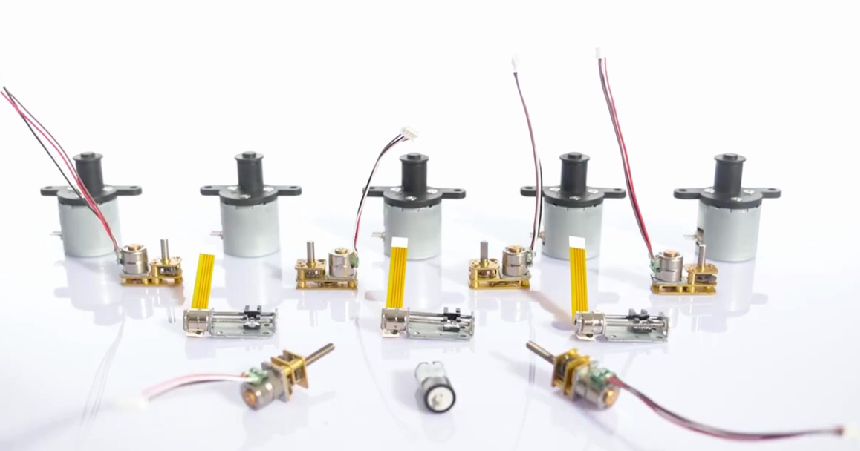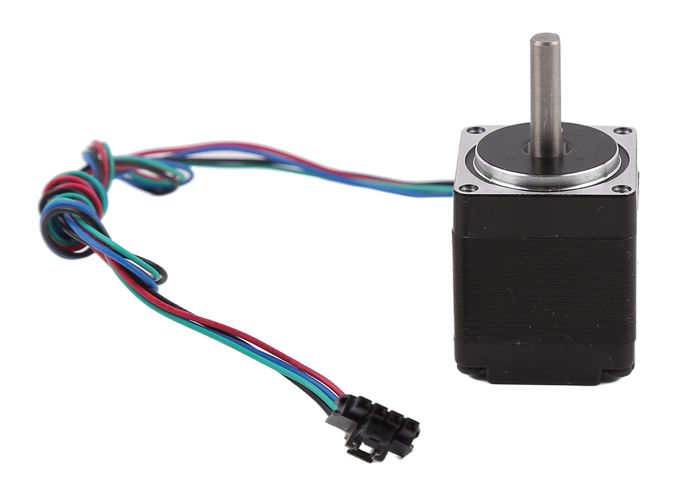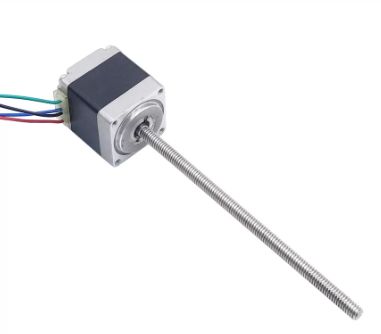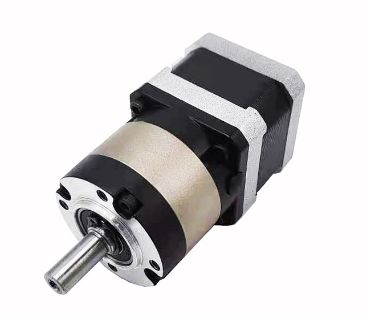Stepper motorso masini gaio'iga fa'apitoa ma se tau maualalo e sili atu nai lo afi servo o masini ia e fa'aliliu ai le malosi fa'ainisinia ma le eletise. O se afi e fa'aliliuina le malosi fa'ainisinia i le eletise e ta'ua o le "generator"; o se afi e liua ai le eletise i le malosi faʻainisinia e taʻua o le "motor". Stepper motors ma servo motors o oloa e pulea le gaioiga e mafai ona maua tonu le gaioiga o masini masini ma le auala e gaoioi ai, ma e masani ona faʻaaogaina i le gaosiga o masini masini.
E tolu ituaiga o stepper motor rotor: reactive (ituaiga VR), maneta tumau (ituaiga PM) ma hybrid (ituaiga HB). 1) Reactive (ituaiga VR): mea faʻaoga ma nifo rotor. 2) Maneta tumau (ituaiga PM): rotor ma maneta tumau. 3) Hybrid (ituaiga HB): mea e fa'aogaina uma ma maneta tumau ma nifo rotor. Stepper motors e faʻavasegaina e tusa ai ma le faʻamalo i luga o le stator: e lua-vaega, tolu-vaega ma le lima-vaega faasologa. O afi e iai ni fa'amau e lua e avea ma afi fa'a-lua-vaega a'o i latou e lima fa'amau e ta'ua o afi lima-vaega. O le tele o vaega ma pa'u o le stepper motor, o le sili atu lea ona sa'o.
HB motors e mafai ona ausia sa'o sa'o la'asaga fa'aopoopo la'asaga, a'o afi PM e masani lava e le mana'omia le sa'o maualuga.HB afie mafai ona ausia lavelave, sa'o laina laina mana'omia e pulea. PM motors e laʻititi laʻititi i le torque ma le voluma, e masani lava e le manaʻomia le maualuga o le pulea, ma e sili atu le taugofie i le tau. Alamanuia: masini ie, afifiina meaai. I le tulaga o le gaosiga o gaioiga ma le saʻo o le pulea o afi,HB stepper afie sili atu tulaga maualuga nai lo PM stepper motors.
Stepper motors ma servo motors o mea uma e pulea gaioioiga, ae eseese i latou faatinoga oloa. O le stepper motor o se masini gaioi fa'apitoa e maua se fa'atonuga ma fa'atino se la'asaga. E fa'aliliu e afi ta'avale le fa'ailoga o le pulupulu fa'aulu i totonu o se fa'ai'uga fa'aitu. A maua e le aveta'avale afi se faailo o le pulupulu, e fa'aosoina le afi fa'asolo e fe'avea'i i se tulimanu fa'amau i le itu fa'atonu. O le servo motor o se servo system lea e fa'aliliuina ai fa'ailo eletise i torque ma saoasaoa e fa'aulu ai se mea fa'atonu, lea e mafai ona fa'atonutonu le saoasaoa ma le tulaga sa'o.
✓ Stepper motors, servo motors e fai si ese'ese i tulaga o uiga maualalo taimi, uiga taimi taimi ma overload gafatia:.
Pulea saʻo: o le tele o vaega ma laina o stepper motors, o le maualuga o le saʻo; o le faʻatonuga saʻo o AC servo motors e faʻamaonia e le rotary encoder i le pito i tua o le afi afi, o le tele encoder fua, o le maualuga o le saʻo.
✓ Uiga maualalo-televave: stepper motors e faigofie i le maualalo-alave vibration mea tutupu i le maualalo saoasaoa, o lenei tulaga maualalo-alave vibration fuafuaina e ala i le mataupu faavae galue o stepper afi e afaina i le faagaoioiga masani o le masini, ma e masani ona faʻaaogaina tekinolosi faʻafefe e faʻatoʻilalo ai le faʻalavelave faʻafuaseʻi o le vibration; AC servo faiga o loʻo i ai le faʻaogaina o le resonance, lea e mafai ona ufiufi ai le leai o se faʻamalosi o le masini. O le taʻaloga e matua lamolemole ma e leai se vibration e tupu e tusa lava pe maualalo le saoasaoa.
✓ Uiga faʻasolosolo: o le faʻauluina o masini stepper e faʻaitiitia i le faʻateleina o le saoasaoa, ma o le maualuga o le saoasaoa o le faʻaogaina o le 300-600RPM; servo motors e mafai ona fa'aulufaleina fa'amauina torque e o'o atu i le saosaoa fa'atatau (e masani lava 2000-3000RPM), ma luga a'e fa'atatau le saoasaoa o le mana fa'aauau.
✓ Ova le uta gafatia: e leai ni mea e mafai ona ova le uta o afi; servo motors i ai malosi overload gafatia.
✓ Fa'atinoga o tali: e alu le 200-400 ms e fa'avavevave ai afi ta'avale mai le tu i le saosaoa (seselau ta'amilosaga i le minute); O le AC servo e sili atu le saoasaoa o le faʻatinoga ma e mafai ona faʻaogaina i tulaga faʻatonutonu e manaʻomia vave amata / taofi. O le Panasonic MASA 400W AC servo, mo se faʻataʻitaʻiga, faʻavavevave mai le tu i lona saoasaoa faʻatatau o le 3000RPM i ni nai milliseconds.
Fa'atinoga fa'atinoga: o ta'avale ta'avale o lo'o fa'atonuina, ma e faigofie ona la'a i lalo po'o poloka pe a maualuga tele le taimi amata pe tele naua le uta, ma fa'ato'ilalo pe a maualuga tele le saoasaoa pe a tu; AC servo o loʻo tapuni tapuni, ma e mafai e le avetaʻavale ona faʻataʻitaʻi saʻo le faʻailoga faʻaalia o le encoder afi, o lea e masani lava e leai se laʻa gau poʻo le soʻona o le stepper motor, ma e sili atu le faʻatuatuaina o le faʻatinoina o le faʻatinoga.
O le AC servo e sili atu nai lo le stepper motor i tulaga o le faʻatinoga, ae o le stepper motor e maua ai le lelei o le tau maualalo. O le AC servo e sili atu nai lo le stepper motors i tulaga o le tali saosaoa, ova le gafatia ma le faʻatinoina o gaioiga, ae o le stepper motors e faʻaaogaina i nisi o faʻataʻitaʻiga e le manaʻomia ona o lo latou tau-faʻaogaina lelei. Faatasi ai ma le faʻaaogaina o tekinolosi tapuni, tapuni tapuni tapuni tapuni e mafai ona maua ai le sao atoatoa ma le lelei, lea e mafai ona ausia nisi o le faatinoga o afi servo, ae o loʻo i ai foi le lelei o le tau maualalo.
Va'ai i luma ma fa'ata'atia vaega o lo'o tula'i mai. O talosaga mo afi Stepper ua faia suiga faʻavae, faʻatasi ai ma le maketi masani e oʻo atu i le saturation ma faʻalauiloa pisinisi fou. O masini faʻatautaia a le kamupani ma mea faʻapipiʻi masini o loʻo tuʻuina atu i totonu o mea faʻafomaʻi, robots auaunaga, masini faʻapisinisi, faʻamatalaga ma fesoʻotaʻiga, saogalemu ma isi pisinisi faʻatupulaia, lea e faʻatatau i se vaega tele o le pisinisi atoa ma o loʻo faʻatupulaia i se saoasaoa vave. O le manaʻoga mo taʻavale stepper e fesoʻotaʻi ma le tamaoaiga, tekinolosi, le maualuga o mea tau pisinisi ma le maualuga o le atinaʻeina faʻapitoa o masini stepper lava ia. O le maketi ua oʻo i le saturation i pisinisi faʻaleaganuʻu e pei o le faʻaogaina o le ofisa, mea pueata numera ma mea faigaluega a le fale, aʻo faʻaauau pea ona faʻaalia pisinisi fou, e pei o le 3D lomitusi, gaosiga o le la, masini faʻafomaʻi ma mea tau taavale.
| fanua | Fa'atatauga fa'apitoa |
| Otometi Ofisa | Lomitusi, sikola, kopi, MFPs, ma isi. |
| Fa'amalama o le Tulaga | Faʻatonuga o le malamalama, taulaʻi, fesuiaʻi lanu, faʻatonuga, faʻamalamalamaga, ma isi. |
| Faletupe | masini ATM, lolomi pili, gaosiga o kata faletupe, masini faitau tupe, ma isi. |
| Fomai | CT scanner, su'esu'e hematology, su'esu'e biochemistry, ma isi. |
| Alamanuia | Masini ie, masini afifi, robots, conveyors, laina faʻapotopotoga, masini faʻapipiʻi, ma isi. |
| Fesootaiga | Fa'ailoga fa'ailoga, fa'atulagaina o antenna feavea'i, ma isi. |
| Saogalemu | Pulea gaioi mo meapueata mata'ituina. |
| Ta'avale | Suau'u / kasa valve pulea, faiga fa'afoe mama. |
Alamanuia Fa'afou 1: Lomitusi 3D o lo'o fa'aauau pea ona faia ni fa'alavelave i tekonolosi R&D ma fa'alautele le fa'atinoina o fa'ata'ita'iga i lalo, fa'atasi ai ma maketi fa'apitonu'u ma fa'ava-o-malo o lo'o fa'atupula'ia i se fua faatatau e tusa ma le 30%. Lomitusi 3D e fa'avae i luga o fa'ata'ita'iga fa'afuainumera, fa'aputu mea fa'apipi'i i lea fa'avae e fai ai mea faitino. O le afi o se vaega taua tele i luga o le lomitusi 3D, o le saʻo o le afi e aʻafia ai le aʻafiaga o le lolomiina 3D, e masani lava o le 3D lomitusi e faʻaaoga ai masini stepper. 2019, o le lalolagi 3D lomitusi fua o alamanuia e $12 piliona, o se siitaga o le 30% tausaga-i-tausaga;.
Alamanuia fa'afou 2: O robots feavea'i o lo'o fa'aogaina komepiuta, fa'atasi ai ma galuega e pei o le fe'avea'i, ta'avale otometi, fa'atonuga tele-sensor, feso'ota'iga feso'otaiga, ma isi.
O lo'o fa'aaogaina afi ta'avale i totonu o le fa'aogaina o masini feavea'i, ma o le fausaga autu o le ta'avale o lo'o fa'apipi'iina mai afi ta'avale ma fa'aitiitiga fa'amau (gearboxes). E ui lava o le fale gaosi oloa gaosi oloa na amata tuai pe a faatusatusa i atunuu i fafo, ae o loʻo i luma atu o atunuu i fafo i le matata o masini feaveaʻi. I le taimi nei, o vaega autu o masini feaveaʻi e tele lava ina gaosia i totonu o le atunuʻu, ma o pisinisi i totonu o le atunuʻu ua ausia le saʻo manaʻomia i itu uma, ma e itiiti ni pisinisi tauva mai fafo.
Ole tele ole maketi masini feaveai a Saina e tusa ma le $6.2 piliona ile 2019, i luga ole 45% i lea tausaga ma lea tausaga. Fa'asalalau fa'ava-o-malo o masini fa'apolofesa fa'amama fa'apolofesa fa'atasi ai ma le fa'ateleina o le fa'amamāina lelei. O le faʻalauiloaina o le "roota lona lua" i le 2018 mulimuli i le faʻalauiloaina o le robot humanoid. O le "roota lona lua" ose masini fa'atauva'a fa'atau pisinisi ma le tele o masini e iloa ai fa'alavelave, fa'asitepu ma gaioiga a tagata. E mafai ona tamo'e mo le tolu itula ile totogi e tasi ma e mafai ona fa'amama e o'o ile 1,500 sikuea mita. O le "roota lona lua" e mafai ona suitulaga i le tele o galuega a le aufaigaluega fa'amama i aso uma ma e mafai ona fa'ateleina le fa'amama ma fa'amama fa'aopoopo i galuega fa'amamā o lo'o iai.
Alamanuia fa'atupuina 3: Fa'atasi ai ma le fa'aofiina o le 5G, o lo'o fa'atupula'ia le aofa'i o antenna mo nofoaga autu o feso'ota'iga ma o lo'o fa'atupula'ia fo'i le numera o afi e mana'omia. I le tulaga lautele, 3 antennas e manaʻomia mo nofoaga masani o fesoʻotaʻiga, 4-6 antennas mo 4G base stations, ma faʻaopoopo atili i le numera o nofoaga autu ma antennas mo talosaga 5G e pei ona manaʻomia e aofia ai fesoʻotaʻiga telefoni feaveaʻi masani ma fesoʻotaʻiga IoT. Pulea oloa afi ma vaega o le atigipusa o lo'o avea ma atina'e masani mo antenna nofoaga autu. E tasi le afi fa'atonu ma le pusa fa'aoga e fa'aoga mo antenna ESC ta'itasi.
O le numera o nofoaga autu 4G na siitia i le 1.72 miliona i le 2019, ma o le fausiaina o le 5G ua faamoemoe e tatalaina se taamilosaga fou. 2019, o le numera o telefoni feaveaʻi i Saina na oʻo atu i le 8.41 miliona, o le 5.44 miliona o 4G base stations, e tusa ma le 65%. 2019, o le numera o nofoaga fou 4G na siitia i le 1.72 miliona, o le tele talu mai le 2015, e mafua ona o le 1) faʻalauteleina fesoʻotaʻiga e ufiufi ai tauaso i nuʻu i tua. 2) O le a faʻaleleia le gafatia o fesoʻotaiga autu e faʻavae ai le faʻavae mo le fausiaina o fesoʻotaʻiga 5G. Ole laisene faapisinisi 5G a Saina o le a tuʻuina atu ia Iuni 2019, ma e oʻo atu ia Me 2020, e silia ma le 250,000 5G nofoaga autu o le a tatalaina i le atunuʻu atoa.
Alamanuia Fa'afou 5: O masini fa'afoma'i o se tasi lea o fa'ata'ita'iga fa'aoga autu mo ta'avale stepper ma o se tasi lea o vaega o lo'o matua'i a'afia ai Vic-Tech. Mai le u'amea i le palasitika, o masini fa'afoma'i e mana'omia ai le maualuga o le sa'o i la latou gaosiga. O le tele o tagata gaosi masini faʻafomaʻi e faʻaaogaina masini servo e faʻafetaui ai le saʻo manaʻomia, ae ona o masini stepper e sili atu le tamaoaiga ma laʻititi nai lo servos, ma o le saʻo e mafai ona fetaui ma nisi o masini faʻafomaʻi, o loʻo faʻaaogaina afi taʻavale i le falemaʻi gaosiga o masini ma e oʻo lava i le suia o nisi masini servo.
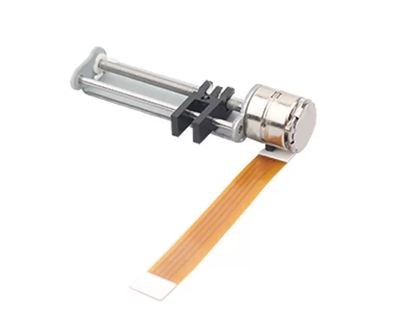
Taimi meli: Me-19-2023

